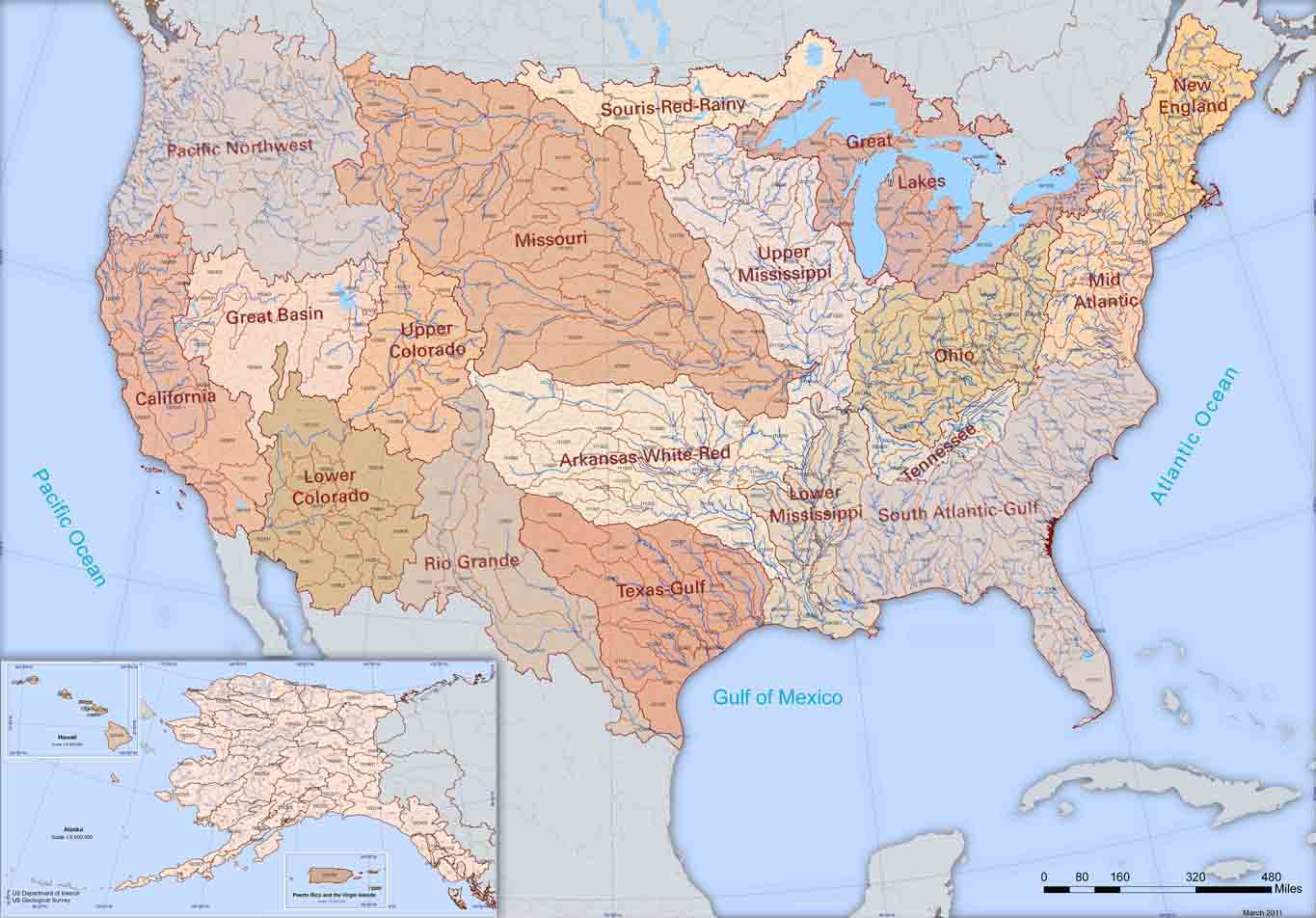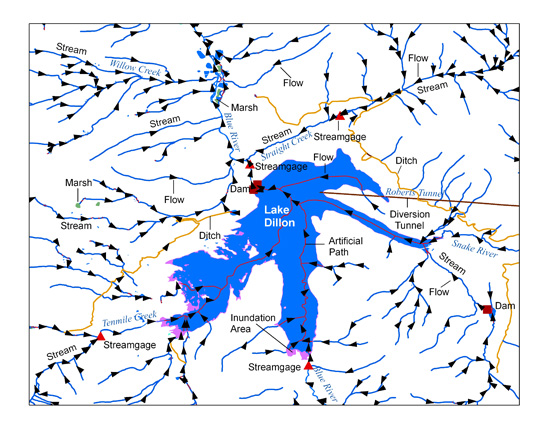Filters: Tags: Subwatershed (X) > Categories: Data (X)
14 results (49ms)|
Filters
Date Range
Extensions Types
Contacts
Tag Types
|
This layer represents the number of Tier 1 fish species known to occur in each HUC10 watershed in the state, according to data available in CPW’s fish database as of December 2014. There are 25 fish species on the Tier 1 SGCN list; a maximum of eight different species occur in the same watershed. This map is an indicator of species richness only; it does not consider relative habitat quality, or population metrics such as density or abundance, across watersheds.
Categories: Data;
Types: Citation,
Downloadable,
Map Service,
OGC WFS Layer,
OGC WMS Layer,
Shapefile;
Tags: Basin,
HUC,
HUC12,
Hydrologic Unit Code,
Hydrologic Units,

The Watershed Boundary Dataset (WBD) from The National Map (TNM) defines the perimeter of drainage areas formed by the terrain and other landscape characteristics. The drainage areas are nested within each other so that a large drainage area, such as the Upper Mississippi River, will be composed of multiple smaller drainage areas, such as the Wisconsin River. Each of these smaller areas can further be subdivided into smaller and smaller drainage areas. The WBD uses six different levels in this hierarchy, with the smallest averaging about 30,000 acres. The WBD is made up of polygons nested into six levels of data respectively defined by Regions, Subregions, Basins, Subbasins, Watersheds, and Subwatersheds. For additional...
This dataset provides a watershed index of surface drinking water importance, a watershed index of forest importance to surface drinking water, and a watershed index to highlight the extent to which development, fire, and insects and disease threaten forests important for surface drinking water. This symbology for this layer is based on the index value for insect and disease threat to forests which are important to surface drinking water on a range from 1-100.
The Forest to Faucets dataset provides a watershed index of surface drinking water importance, a watershed index of forest importance to surface drinking water, and a watershed index to highlight the extent to which development, fire, and insects and disease threaten forests important for surface drinking water. This layer displays the percent of the HUC watershed that is threatened bu insects and disease. For further information, see the methods paper titled, “From the Forest to the Faucet: Drinking Water and Forests in the US” located at http://www.fs.fed.us/ecosystemservices/FS_Efforts/forests2faucets.shtml.
This dataset provides a watershed index of surface drinking water importance, a watershed index of forest importance to surface drinking water, and a watershed index to highlight the extent to which development, fire, and insects and disease threaten forests important for surface drinking water. The results of this assessment provides information that can identify areas of interest for protecting surface drinking water quality. The spatial dataset can be incorporated into broad-scale planning, such as the State Forest Action Plans, and can be incorporated into existing decision support tools that currently lack spatial data on important areas for surface drinking water. This project also sets the groundwork for...
The USGS National Hydrography Dataset (NHD) is a comprehensive set of digital spatial data that encodes information about naturally occurring and constructed bodies of surface water (lakes, ponds, and reservoirs), paths through which water flows (canals, ditches, streams, and rivers), and related entities such as point features (springs, wells, stream gages, and dams). The information encoded about these features includes classification and other characteristics, delineation, geographic name, position and related measures, a "reach code" through which other information can be related to the NHD, and the direction of water flow. The network of reach codes delineating water and transported material flow allows users...
Categories: Data;
Tags: Administrative watershed units,
Area of Complex Channels,
Area to be submerged,
Aroostook County,
Artificial path,
This dataset provides a watershed index of surface drinking water importance, a watershed index of forest importance to surface drinking water, and a watershed index to highlight the extent to which development, fire, and insects and disease threaten forests important for surface drinking water. This symbology for this layer is based on the index value for insect and disease threat to forests which are important to surface drinking water on a range from 1-100.
Categories: Data;
Types: ArcGIS REST Map Service,
ArcGIS Service Definition,
Citation,
Downloadable,
Map Service;
Tags: HUC,
HUC 12,
United States,
development,
disease,
This data set is a complete digital hydrologic unit boundary layer of the Subbasin (10-digit) 5th level for the entire United States, clipped to the Northeast. A hydrologic unit (HU) is a drainage area delineated to nest a multi-level, hierarchical drainage system. Its boundaries are defined by a hydrographic and topographic criteria that delineate an area of land upstream from a specific point on a river, stream, or similar surfaces waters. An HU can accept surface water directly from upstream drainage areas, and indirectly from associated surface areas such as remnant, non-contributing, and diversions to form a drainage area with single or multiple outlet points. HUs are only synonymous with classic watersheds...
Categories: Data;
Types: ArcGIS REST Map Service,
ArcGIS Service Definition,
Downloadable,
Map Service;
Tags: Canada,
HUC,
HUC8,
Mexico,
Puerto Rico,
This data set is a complete digital hydrologic unit boundary layer of the Subbasin (8-digit) 4th level for the entire United States, clipped to the Northeast. A hydrologic unit (HU) is a drainage area delineated to nest a multi-level, hierarchical drainage system. Its boundaries are defined by a hydrographic and topographic criteria that delineate an area of land upstream from a specific point on a river, stream, or similar surfaces waters. An HU can accept surface water directly from upstream drainage areas, and indirectly from associated surface areas such as remnant, non-contributing, and diversions to form a drainage area with single or multiple outlet points. HUs are only synonymous with classic watersheds...
Categories: Data;
Types: ArcGIS REST Map Service,
ArcGIS Service Definition,
Downloadable,
Map Service;
Tags: Canada,
HUC,
HUC8,
Mexico,
Puerto Rico,
The Forest to Faucets dataset provides a watershed index of surface drinking water importance, a watershed index of forest importance to surface drinking water, and a watershed index to highlight the extent to which development, fire, and insects and disease threaten forests important for surface drinking water. This layer displays the percent of the HUC watershed that is threatened bu insects and disease. For further information, see the methods paper titled, "From the Forest to the Faucet: Drinking Water and Forests in the US" located at http://www.fs.fed.us/ecosystemservices/FS_Efforts/forests2faucets.shtml.
Categories: Data;
Types: ArcGIS REST Map Service,
ArcGIS Service Definition,
Citation,
Downloadable,
Map Service;
Tags: HUC,
HUC 12,
United States,
development,
disease,

The USGS National Hydrography Dataset (NHD) service from The National Map (TNM) is a comprehensive set of digital spatial data that encodes information about naturally occurring and constructed bodies of surface water (lakes, ponds, and reservoirs), paths through which water flows (canals, ditches, streams, and rivers), and related entities such as point features (springs, wells, stream gages, and dams). The information encoded about these features includes classification and other characteristics, delineation, geographic name, position and related measures, a "reach code" through which other information can be related to the NHD, and the direction of water flow. The network of reach codes delineating water and...
Categories: Data;
Types: ArcGIS REST Map Service,
Map Service;
Tags: HU,
Hydrography,
NGP-TNM,
NHD,
Overlay Map Service,
This dataset provides a watershed index of surface drinking water importance, a watershed index of forest importance to surface drinking water, and a watershed index to highlight the extent to which development, fire, and insects and disease threaten forests important for surface drinking water.
Categories: Data;
Types: ArcGIS REST Map Service,
ArcGIS Service Definition,
Citation,
Downloadable,
Map Service;
Tags: HUC,
HUC 12,
United States,
development,
disease,
This data set is a complete digital hydrologic unit boundary layer of the Subbasin (12-digit) 6th level for the entire United States, clipped to the Northeast. A hydrologic unit (HU) is a drainage area delineated to nest a multi-level, hierarchical drainage system. Its boundaries are defined by a hydrographic and topographic criteria that delineate an area of land upstream from a specific point on a river, stream, or similar surfaces waters. An HU can accept surface water directly from upstream drainage areas, and indirectly from associated surface areas such as remnant, non-contributing, and diversions to form a drainage area with single or multiple outlet points. HUs are only synonymous with classic watersheds...
Categories: Data;
Types: ArcGIS REST Map Service,
ArcGIS Service Definition,
Downloadable,
Map Service;
Tags: Canada,
Mexico,
Puerto Rico,
U.S.,
U.S. Territories,
Aquatic Ecological Focus Areas were based on The Nature Conservancy’s priority streams and by the Special Aquatic Life Use streams defined by the Kansas Department of Health and Environment, with some exclusions based on expert opinion. The selected streams were buffered by 100 m; 12-digit HUCs that intersect the buffers comprise the EFAs.
Categories: Data;
Types: Citation,
Downloadable,
Map Service,
OGC WFS Layer,
OGC WMS Layer,
Shapefile;
Tags: Basin,
HUC,
Hydrologic Unit Code,
Hydrologic Units,
Region,
|

|